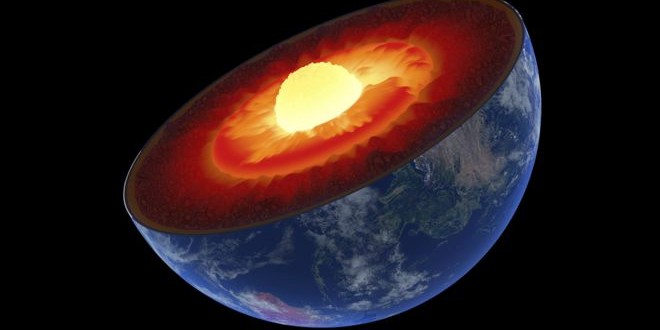New analysis of ancient rock samples suggest Earth’s inner core formed between 1 and 1.5 billion years ago.
The inner core is Earth’s deepest layer. It is a ball of solid iron just larger than Pluto which is surrounded by a liquid outer core. The inner core is a relatively recent addition to our planet and establishing when it was formed is a topic of vigorous scientific debate with estimates ranging from 0.5 billion to 2 billion years ago.
In a new study published in Nature, researchers from the University’s School of Environmental Sciences analysed magnetic records from ancient igneous rocks and found that there was a sharp increase in the strength of the Earth’s magnetic field between 1 and 1.5 billion years ago.
Magnetic records
This increased magnetic field is seen as a likely indication of the first occurrence of solid iron at Earth’s centre and the point in Earth’s history at which the solid inner core first started to “freeze” out from the cooling molten outer core.
Liverpool palaeomagnetism expert and the study’s lead author, Dr Andy Biggin, said: “This finding could change our understanding of the Earth’s interior and its history.
“The timing of the first appearance of solid iron or “nucleation” of the inner core is highly controversial but is crucial for determining the properties and history of the Earth’s interior and has strong implications for how the Earth’s magnetic field – which acts as a shield against harmful radiation from the sun, as well as a useful navigational aid – is generated.
“The results suggest that the Earth’s core is cooling down less quickly than previously thought which has implications for the whole of Earth Sciences. It also suggests an average growth rate of the solid inner core of approximately 1mm per year which affects our understanding of the Earth’s magnetic field.”
Earth’s magnetic field
The Earth’s magnetic field is generated by the motion of the liquid iron alloy in the outer core, approximately 3,000 km beneath the Earth’s crust. These motions occur because the core is losing heat to the overlying solid mantle that extends up to the crust on which we live producing the phenomenon of convection.
Once the inner core started to freeze, this convection received a strong boost in power because light, non-metallic elements remained molten in the outer core and were buoyant relative to the overlying liquid. The process continues today and is thought to be the main source of “fuel” for generating the Earth’s magnetic field.
Dr Biggin, from the School of Environmental Sciences, added: “The theoretical model which best fits our data indicates that the core is losing heat more slowly than at any point in the last 4.5 billion years and that this flow of energy should keep the Earth’s magnetic field going for another billion years or more.
“This contrasts sharply with Mars which had a strong magnetic field early in its history which then appears to have died after half a billion years.”
Agencies/Canadajournal
 Canada Journal – News of the World Articles and videos to bring you the biggest Canadian news stories from across the country every day
Canada Journal – News of the World Articles and videos to bring you the biggest Canadian news stories from across the country every day



